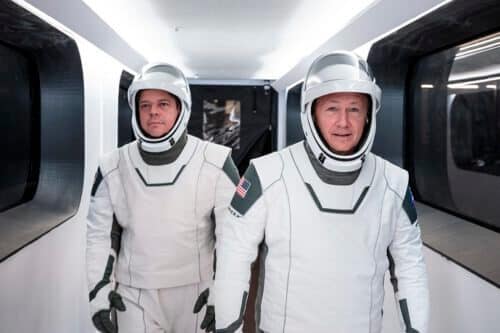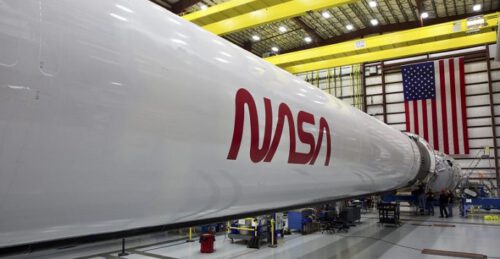NASA and SpaceX have reached the moment of truth * This is the first launch of American astronauts from US soil since 2011 - and the first launch in history of astronauts in a private spacecraft
By Oded Carmeli, Israel Space Agency website
22: 30 - Live preview of NASA's new manned program on the space agency's Facebook page.
Live broadcast of the launch itself here:
Tonight, Wednesday, 27/5/20, at 23:33 p.m. Israel time, astronauts Bob Benken and Doug Hurley will make history when they are launched into space aboard a Falcon 9 launcher and aboard a Dragon 2 spacecraft - both owned by the commercial company SpaceX. This is the first launch of American astronauts from US soil since 2011 - and the first launch in history of astronauts in a private spacecraft. So fasten your seat belts: here is everything you wanted to know about the complex, sensitive and exciting operation, "Launch America".
How did the Americans fly into space until today?
Since the end of the space shuttle program in 2011, American astronauts have flown into space aboard Russian Soyuz-type spacecraft and launchers, with the launches regularly taking place from the Baikonur Cosmodrome spaceport in Kazakhstan. Astronauts Benken and Hurley will be the first to fly from launch pad 39A, from which the Apollo spacecraft and space shuttles were launched in the past, at the Kennedy Space Center in Florida. They will also be the first astronauts to drive the launch in a Tesla electric car - a covert (and actually quite visible) advertisement courtesy of Elon Musk, founder of Tesla and SpaceX.
Where are the astronauts flying and for what purpose?
The Falcon 9 launcher will launch Banken and Harley into space at a speed of about 27,000 km/h - and on an interception path with the International Space Station. After about 24 hours in orbit around the Earth, when they make sure that all the spacecraft systems are working - Dragon 2 will dock at the space station. At this point it is not known how long Benken and Hurley will stay at the station, since the purpose of the Demo-2 mission is to test the spacecraft for the next missions. This is the first time in the history of space exploration that astronauts can test a new spacecraft from the comfort of the space station.
What is special about the new spacecraft?
Dragon 2 is the fifth American spacecraft in history, after Mercury (1961), Gemini (1965), Apollo (1968) and the Space Shuttle (1981) - and the first manned commercial spacecraft. Dragon 2 can carry no less than seven astronauts to the International Space Station (although NASA does not intend to launch more than four at a time) and autonomously dock at the station. Like the space shuttles, the Dragon 2 is also a reusable spacecraft: after landing in water, a new nose can be assembled in place of the nose that withstood the tremendous heat of re-entry into the atmosphere, refueled and take off again into space.
Why does NASA need Elon Musk - it doesn't have its own spacecraft?
It is important to understand that SpaceX does not compete with NASA. On the contrary: NASA is the company's largest investor and customer. In 2010, a principled decision was made in the American government to single out NASA for scientific research in space - and to encourage the private sector to produce the launchers and spacecraft for the space agency's astronauts. Thus, NASA will focus on breaking scientific and space boundaries, while at the same time private companies will get the opportunity to develop launch capabilities that will also be used for commercial purposes, such as space tourism.
In 2014, development grants were awarded to two companies to develop the tools to transport astronauts to the space station: SpaceX and Boeing. In 2012, SpaceX became the first commercial company in the world to launch a spacecraft into orbit around Israel and return it to Israel when it launched the Dragon cargo spacecraft to the space station. On Wednesday, she will do so with Dragon 2 and live astronauts. Whereas Boeing is in the advanced stages of development of the CST-100 Starliner spacecraft. Although SpaceX reached the finish line before Boeing, as early as 2021, astronauts Chris Ferguson, Mike Finke and Nicole Mann will fly to the space station aboard the Starliner. At the same time, NASA is developing its spacecraft - Orion, which will carry astronauts to more distant destinations such as the moon and Mars.

What has changed in space suits?
Even those who don't follow the news from space will surely notice one notable change: SpaceX's amazing spacesuits. The space shuttles used the orange ACES (Advanced Crew Escape Suit), while the Soyuz launches used the white Russian Sokol suits. Both of these are heavy and bulky compared to SpaceX's new suits, which look like they were taken from a sci-fi movie set. This is no coincidence: the designer of the Spice X suits is the legendary Hollywood designer Jose Fernandez - who is responsible, among other things, for the costumes in films such as "Wonder Woman". The suits will be used by Banken and Hurley in case of an emergency of loss of pressure in the spacecraft, including a breathing system that will supply the astronauts with oxygen and remove carbon dioxide.

What happened to the NASA logo?
The American space agency uses two symbols: the "meatball" logo, which was used by NASA in the years 1952-1975, and from 1992 onwards, and the "worm" logo, which was used by the agency between 1975 and 1992. On the occasion of the historic launch, NASA Administrator Jim Bridenstine decided that the Crew-Demo 2 mission would fly under the Worm logo. The logo, designed by Richard Dane and Bruce Blackburn, was intended to be more modern than the original NASA logo - but today it looks like a cool retro from the eighties.
More of the topic in Hayadan:
- The history: the first private manned launch to the space station - on Wednesday 27/5/2020
- SpaceX launched an experimental version of the Dragon crew spacecraft to the space station (2019, unmanned launch)
